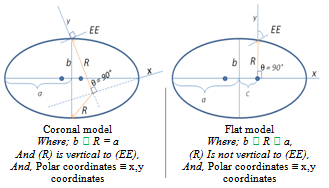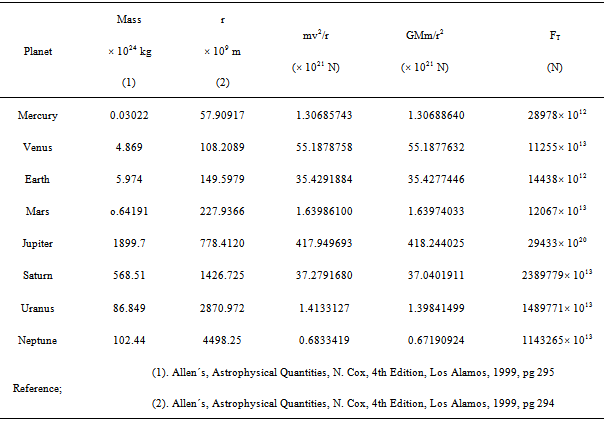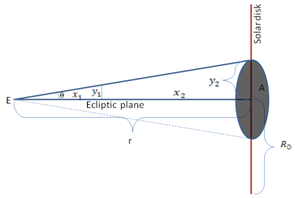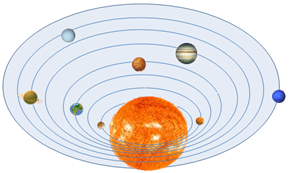Mohammad T. Al -Tamimi
The National Center for Publishing, Jordan, Irbid
Correspondence to: Mohammad T. Al -Tamimi , The National Center for Publishing, Jordan, Irbid.
| Email: |  |
Copyright © 2012 Scientific & Academic Publishing. All Rights Reserved.
Abstract
After the collapse of kepler’s first law[1], it becomes too important to talk about the real theory of planetary motion and to determine the accurate coordinates of the center of mass of our solar system.
Keywords:
Astrophysics, Planetary, Motion, Astronomy
1. Introduction
Astronomy seems too simple, but - in fact- we have –there- many complicated traps. During last ages of human life, when he was observing the sky, human decided that the universe moves around his land (Earth)[2]. After Eighteen centuries ago, he realized that is an optical illusion, then Copernicus deduced that Aristotle’s Universe is wrong. In 1609 kepler deduced that the heliocentric theory was also wrong, because he discovered that “each planet moves along ellipse, with Sun at one of foci”[3]. Earlier to 2009, I discovered that we have some problems in Kepler’s first law, where I decided to review all data of Earth’s Orbit (EO), after I was observing the celestial sphere for long time. Anyway, I think that the following data are too necessary to make any progress in this field:• Angular acceleration  .• Angular speed (ω) on elliptical orbit is changeable from second to second.•
.• Angular speed (ω) on elliptical orbit is changeable from second to second.• .•
.•  •
•  •
•  • Minor-axis of ellipse (2b) ≠ major-axis (2α)• Stability of planet on its orbit means;
• Minor-axis of ellipse (2b) ≠ major-axis (2α)• Stability of planet on its orbit means;  •
•  •
•  • The star proper motion
• The star proper motion  •
•  •
• 
2. Objectives and Questions of this Research
In this research the following questions will be explained and fully answered.2.1. Is there a constant rate of change for the distance between Sun and planet during the year?2.2. Can we put the correct explanation for ascension and declining of the diurnal path of the Sun above the horizon during the four seasons?2.3. Can we rewrite the theory of planetary motion?
3. Review of Kepler’s First Law
I think that Kepler’s first law has two faces of one coin; 3.1. Mathematical law which is not suitable to calculate the moment distance between Sun and planet. For example; when we want to determine the distance (R) between Sun and Earth when Earth is located at polar coordinates to the center of mass , we note that, Kepler’s first law could not give us the real distance:
, we note that, Kepler’s first law could not give us the real distance: | (1) |
For that, when we choose a center of mass reference frame for a binary system, we find;  And when we return to equation (1) we find: (R90o < ɑ), but in my view: (R90o = α).To prove this idea, we can say that the distance between Sun and planet has a constant (l) rate of change, that we can obtain it by the following equation:
And when we return to equation (1) we find: (R90o < ɑ), but in my view: (R90o = α).To prove this idea, we can say that the distance between Sun and planet has a constant (l) rate of change, that we can obtain it by the following equation: | (2) |
 So; the accurate law for determining the exact distance between Sun and planet when it moves from perihelion to aphelion, is given by:
So; the accurate law for determining the exact distance between Sun and planet when it moves from perihelion to aphelion, is given by: | (3) |
So, we find;  | (4) |
But the accurate law for determining the real distancebetween Sun and planet when it moves from aphelion to perihelion, is given by: | (5) |
Something else, when we want to determine the length of minor-axis of orbit, we use this formula:  which means that the difference between minor-axis and major-axis of Earth’s orbit is not more than 21×103 km. In my view, the truth is not reflected by this difference, because we have an experimental theory about ellipse says: {oblateness (
which means that the difference between minor-axis and major-axis of Earth’s orbit is not more than 21×103 km. In my view, the truth is not reflected by this difference, because we have an experimental theory about ellipse says: {oblateness ( ) of ellipse is directly proportional to the distance between focus and center of that ellipse (c)}. For that; ellipse becomes line when (c =∞) , and becomes circle when (c = 0). Then, we can say that; if (c = 0) then (α=b), and if (c = ∞) then (α= ∞, b = 0) .
) of ellipse is directly proportional to the distance between focus and center of that ellipse (c)}. For that; ellipse becomes line when (c =∞) , and becomes circle when (c = 0). Then, we can say that; if (c = 0) then (α=b), and if (c = ∞) then (α= ∞, b = 0) .  | (6) |
So; we can use a simple equation for determining the length of minor-axis of orbit:  | (7) |
3.2. Physical theory which is “unable to make any progress towards a correct dynamical view of planetary motion”[4]because it could not “place the focus of orbital ellipse at the center of gravity”[5] . For that, I think that we still have a “task of demonstrating the relationship between the laws of kepler and Newton”[6]because there is a scientific distance between the flat model (which puts the center of Sun at major axis of orbit), and the coronal model (which believes that the Sun occupies the top of the semi-conical body of solar system). It is too simple to prove that, just refer to (1), (4) and take a look at figure -1, when planet is located at polar coordinates. According to the observational data, I noted that the Sun’s ray at noon at equinox falls vertically at Earth’s Equator (EE) and when I analyze the whole equation concerning ellipse, I note this ray should be longer than (b) and equal (a), but in the flat model, when Kepler believed that the major axis of orbit is passing through the center of mass, we note (theoretically and physically) that one of output of kepler’s first law is wrong:  . See figure -1.To prove my view, we can use formula (3)and (7) to realize that:
. See figure -1.To prove my view, we can use formula (3)and (7) to realize that: | (8) |
Something else, when Kepler put the center of mass at focus, as seems in the flat model in figure -1, we note that (EE) could not parallel x-axis. therefore; Sun’s ray, with polar coordinates could not fall vertically on (EE), which we find a huge deference between these notes and the observational data. For that, when we choose the flat model, as seems in figure -1, we find the angular acceleration is swimming out of dynamics: 
 The golden rule in dynamics says; angular acceleration equals zero if angular speed is steady and FT = 0. But when we go to put the center of mass out of two foci, as seems in coronal model in figure -1, we find (x-axis) parallel (EE) when Earth is located at Equinox, also, at the same time we find the Sun’s ray is vertically falling on (EE), where we find these results match with the observational data.
The golden rule in dynamics says; angular acceleration equals zero if angular speed is steady and FT = 0. But when we go to put the center of mass out of two foci, as seems in coronal model in figure -1, we find (x-axis) parallel (EE) when Earth is located at Equinox, also, at the same time we find the Sun’s ray is vertically falling on (EE), where we find these results match with the observational data. | Figure 1. Polar coordinates |
Therefore, a continuous change of the inclination of (EE) to Ecliptic plane had been proved: (23.4607188°) when Earth is at perihelion, and (23.4381042°) when Earth is at aphelion[1], which means; the inclination of the tropic of Cancer to ecliptic plane, when Earth is located at perihelion, equals 0.0107188° (θ1 in figure-4), and the inclination of the Capricorn to ecliptic plane, when Earth is located at aphelion, equals 0.0214376°. Due to this continuous change, we can put the correct explanation for ascension and declining of the diurnal path of the Sun above the horizon during the four seasons, where we observe this path in winter is closer to the horizon than in summer. (9)Indeed, these results encouraged me to review the history of the transit of Venus[7], especially when Venus passes between Sun and Earth, where I asked myself; due to the flat model, three objects should be at one level at nodal line (inferior conjunction), and the dark spot should be seen (one day) from Earth, exactly across the center of solar disk, where we find the area (A) of this dark spot should be equals 34.8% of solar disk[8] as seen in figure -2, which is different from the truth.  | Figure 2. According to the flat model,the size of the transit of Venus should be seemed bigger than we observed and an annual eclipse by venus should be shown, but this phenomena did not ever happened |
Table (1). Differences between F12 and F21 in solar system
 |
| |
|
To prove this misunderstanding view, which is depending on the flat model, we can use the following equations; | (10) |
where;  | (11) |
so;  | (12) |
where; (r) is the distance between Sun and Earth and (y2) is the radius of dark spot as seen from Earth (E). see figure – 3 | Figure 3. Shadow of venus as seen from Earth in the time of inferior conjunction depending on the flat model |
Rule says; (y2) is the shadow of (y1) as seen from (E), but the field observation data proved that the transit of Venus had never observed (exactly) at the center of solar disk, it just passed on 23 Nov 424 (9.6′′) from the center of Sun[9]. Also, Venus was shown at inferior conjunction as a new moon (crescent) contrary to superior conjunction, where it was shown as a full moon[10], and the shadow of Venus on solar disk (during the transit) had never shown bigger than 1/32 of the Sun's apparent diameter. Overall, when we want to check Kepler’s first law by laws of gravitational attraction, we find that the planets of our solar system have no stability on its orbits, especially with Jupiter case, where we find: So we have something wrong in the current theory of planetary motion which depends on flat model. see table-1Therefore, we are strongly encouraged to develop an accurate image for the coordinates of Sun’s mass on the map of our solar system.
So we have something wrong in the current theory of planetary motion which depends on flat model. see table-1Therefore, we are strongly encouraged to develop an accurate image for the coordinates of Sun’s mass on the map of our solar system.
4. Coordinates of Sun’s mass
I think, there is a complex process concerning to know the accurate location of Sun in solar system, because we have some missing data in the dynamical astronomy.For that, we need – firstly - to know all lengths and distances of (EO), which we need to establish a data base for these coordinates. | Figure 4. Coordinates the center of Sun |
Referring to Figure -4, and keeping in mind the data of this research, we find that: | (13) |
And, | (14) |
To define the accurate quantity of  , we can use the following formula;
, we can use the following formula; | (15) |
With neglecting the difference between  (about 120 meters), we can say that;
(about 120 meters), we can say that;  | (16) |
To define the distance between center of Sun and the ecliptic plane, we can use formula: | (17) |
 | (18) |
So, Sun occupies its place out of the two foci. which means that we have a solar system had been built by semi-conical orbits. See figure – 5. | Figure 5. Conical orbits |
For that; 4.1. We had never observed that the transit of Venus was taking place across the middle of the solar disk, when Venus passes directly between earth and the sun (inferior conjunction).4.2. We had observed Venus phases as a crescent (at inferior conjunction) or as a full moon (at superior conjunction).4.3. When we are talking about inferior conjunction or superior conjunction, we had never observed any one of outer planets appears as a new moon (crescent).
5. Conclusions
I think that; this research had achieved its objectives, produced good answers for its questions and brought a new theory of planetary motion which I can rewrite it as follows: Each planet moves around the Sun along elliptical or circular orbit, where Sun occupies the top of semi- conical body of solar system, (orbits above each other) as seem in figure-5.
References
| [1] | M.T.K Al –Tamimi; Great collapse Kepler’s first law, Natural Science, 2, (2010) pp. 786-792. ISSN Print: 2150-4091, ISSN Online: 2150-4105. |
| [2] | Aristotle's theory, (about 350 BC) see: Feldman, Fred; "The Open Question Argument: What It Isn't; and What It Is", Philosophical Issues, vol. 15 Issue 1, (2005), pages 22–43. |
| [3] | Grald Holton and Stephen G. Brush; Physics the Human Addventure from Copernicus and Byond, third edition,2004, Addison Weslon, pg.40. |
| [4] | H.C. Plummer, M.A; An introductory treatise on dynamical astronomy, Cambridge, 1918, pg.2. |
| [5] | David p. Stern; Refining the first law, Harvard,2010,http://www.phy6.org/stargaze/Skepl1stA.htm. |
| [6] | Andrew T. Hyman; A simple Cartesian treatment of planetary motion, Eur.j.Phys, 14, (1993) pg.147. printed in UK. |
| [7] | see:http://astro.ukho.gov.uk/nao/transit/V_1032/ |
| [8] | Astronomers say that the Venus “appears to be only 1/32 of the Sun's apparent diameter”. Newcomb, S., 1895,"Tables of the Motion of the Earth on its Axis Around the Sun", Astron. Papers Amer. Eph., Vol. 6, Part I. |
| [9] | E-mail from Dr. John Westfall to me on May 25 (2011). |
| [10] | see;http://www.eso.org/public//outreach/eduoff/vt-2004/mt-2003/mt-mercury-orbit.html |

 .• Angular speed (ω) on elliptical orbit is changeable from second to second.•
.• Angular speed (ω) on elliptical orbit is changeable from second to second.• .•
.•  •
•  •
•  • Minor-axis of ellipse (2b) ≠ major-axis (2α)• Stability of planet on its orbit means;
• Minor-axis of ellipse (2b) ≠ major-axis (2α)• Stability of planet on its orbit means;  •
•  •
•  • The star proper motion
• The star proper motion  •
•  •
• 
 , we note that, Kepler’s first law could not give us the real distance:
, we note that, Kepler’s first law could not give us the real distance:
 And when we return to equation (1) we find: (R90o < ɑ), but in my view: (R90o = α).To prove this idea, we can say that the distance between Sun and planet has a constant (l) rate of change, that we can obtain it by the following equation:
And when we return to equation (1) we find: (R90o < ɑ), but in my view: (R90o = α).To prove this idea, we can say that the distance between Sun and planet has a constant (l) rate of change, that we can obtain it by the following equation:
 So; the accurate law for determining the exact distance between Sun and planet when it moves from perihelion to aphelion, is given by:
So; the accurate law for determining the exact distance between Sun and planet when it moves from perihelion to aphelion, is given by:


 which means that the difference between minor-axis and major-axis of Earth’s orbit is not more than 21×103 km. In my view, the truth is not reflected by this difference, because we have an experimental theory about ellipse says: {oblateness (
which means that the difference between minor-axis and major-axis of Earth’s orbit is not more than 21×103 km. In my view, the truth is not reflected by this difference, because we have an experimental theory about ellipse says: {oblateness ( ) of ellipse is directly proportional to the distance between focus and center of that ellipse (c)}. For that; ellipse becomes line when (c =∞) , and becomes circle when (c = 0). Then, we can say that; if (c = 0) then (α=b), and if (c = ∞) then (α= ∞, b = 0) .
) of ellipse is directly proportional to the distance between focus and center of that ellipse (c)}. For that; ellipse becomes line when (c =∞) , and becomes circle when (c = 0). Then, we can say that; if (c = 0) then (α=b), and if (c = ∞) then (α= ∞, b = 0) . 

 . See figure -1.To prove my view, we can use formula (3)and (7) to realize that:
. See figure -1.To prove my view, we can use formula (3)and (7) to realize that:

 The golden rule in dynamics says; angular acceleration equals zero if angular speed is steady and FT = 0. But when we go to put the center of mass out of two foci, as seems in coronal model in figure -1, we find (x-axis) parallel (EE) when Earth is located at Equinox, also, at the same time we find the Sun’s ray is vertically falling on (EE), where we find these results match with the observational data.
The golden rule in dynamics says; angular acceleration equals zero if angular speed is steady and FT = 0. But when we go to put the center of mass out of two foci, as seems in coronal model in figure -1, we find (x-axis) parallel (EE) when Earth is located at Equinox, also, at the same time we find the Sun’s ray is vertically falling on (EE), where we find these results match with the observational data.




 So we have something wrong in the current theory of planetary motion which depends on flat model. see table-1Therefore, we are strongly encouraged to develop an accurate image for the coordinates of Sun’s mass on the map of our solar system.
So we have something wrong in the current theory of planetary motion which depends on flat model. see table-1Therefore, we are strongly encouraged to develop an accurate image for the coordinates of Sun’s mass on the map of our solar system.


 , we can use the following formula;
, we can use the following formula;
 (about 120 meters), we can say that;
(about 120 meters), we can say that; 



 Abstract
Abstract Reference
Reference Full-Text PDF
Full-Text PDF Full-Text HTML
Full-Text HTML
